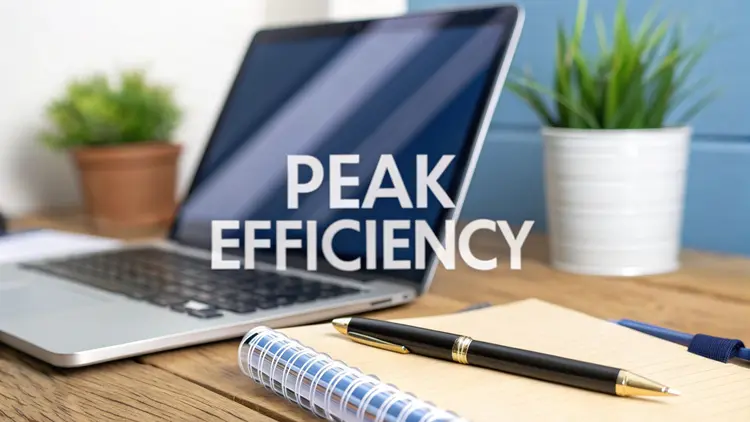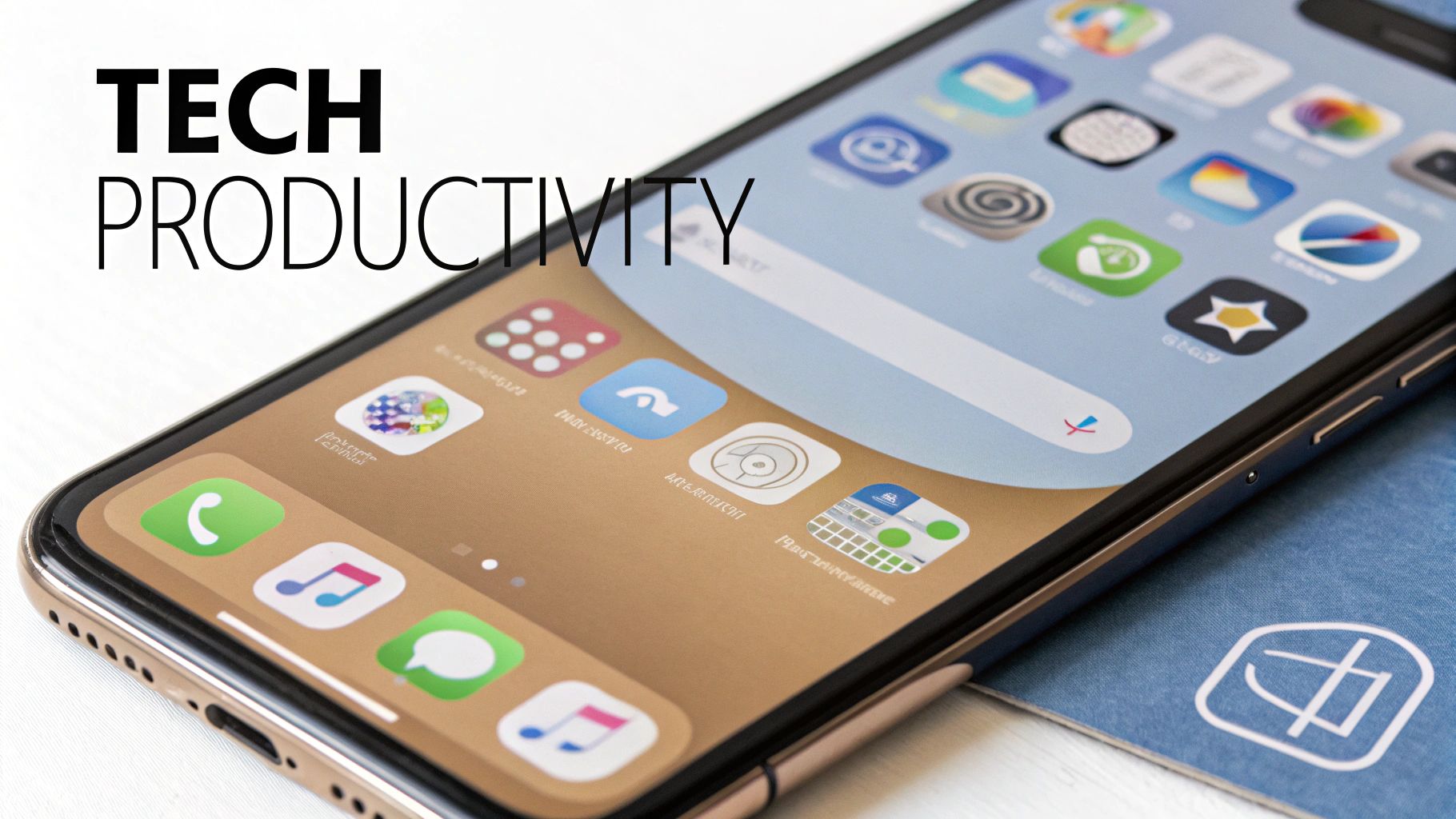Getting more done at work isn’t about pushing harder – it’s about making smart choices about how we work. Success comes from understanding how individuals, teams, and organizations can work together effectively. For example, top companies recognize that many factors influence productivity, from personal motivation to the tools people use.
The Role of Skill Development
Ongoing employee training and education plays a vital role in improving work efficiency. When companies invest in developing their people’s abilities, both the employees and organization benefit. A skilled workforce adapts better to industry changes and drives innovation. Research shows that between 1948-1990, 11-20% of labor productivity growth in the US came from increased education levels. Learn more about education’s impact on productivity.
The Impact of Clear Goals and Effective Processes
Having well-defined goals and objectives makes a big difference in work efficiency. When everyone understands what they’re working toward and how their role contributes, they can focus their efforts more effectively. This clarity helps avoid wasted time and keeps everyone aligned. Simple, straightforward processes are also key – complicated approval steps or too much paperwork slow things down. By removing these barriers, organizations free up time for more valuable work.
Psychological Factors Influencing Peak Performance
The mental and emotional aspects of work efficiency are just as important as the practical ones. Stress, worry, and lack of focus can really impact how well someone performs their job. This is why creating a supportive workplace that prioritizes employee wellbeing matters so much.

Companies need to identify and address sources of stress while giving people resources to manage their mental health. Simple techniques can help overcome procrastination, such as breaking big projects into smaller tasks and setting clear deadlines. When organizations pay attention to these psychological factors, they create an environment where people can do their best work.
Productivity Systems Tailored for Affiliate Marketers
Affiliate marketing is a fast-paced world where juggling campaigns, partnerships, and performance metrics can feel overwhelming. But here’s the good news: with the right productivity system, you can stay on top of it all and even find time to breathe.
1. Find Your Golden Hours Just like athletes have peak training times, affiliate marketers have peak focus hours. Maybe you’re sharpest early in the morning, or perhaps your creativity kicks in after lunch. Use tools like Google Calendar or time-tracking apps to figure out when you’re most productive, then schedule your high-priority tasks—like campaign strategy or content creation—during those golden hours.
2. Bullet Journaling for Campaign Management Yes, bullet journaling is not only for personal goals and grocery lists, but it can also significantly impact affiliate marketers. Create a simple layout to track campaigns, deadlines, and performance metrics. For example:
- A daily log for tasks like reaching out to partners or checking analytics.
- A habit tracker for consistent tasks, such as posting on social media or updating affiliate links.
- A goal section to visualize your monthly revenue targets.
The beauty of a bullet journal is its flexibility. You can design it to fit your workflow perfectly.
3. Embrace Automation Tools Let’s face it—time is money in affiliate marketing. Tools like Scaleo can automate repetitive tasks like tracking affiliate performance, generating reports, and even fraud detection. This means you spend less time crunching numbers and more time building relationships and scaling your business. Pair this with email automation tools to follow up with partners or send campaign updates effortlessly.
4. Prioritize with the Eisenhower Matrix Affiliate marketers often face a mountain of to-dos, from analyzing data to brainstorming new content ideas. The Eisenhower Matrix can help you sort tasks into:
- Urgent and Important: Tasks that need your immediate attention (e.g., fixing a broken affiliate link).
- Important but Not Urgent: Long-term strategies, like planning a new campaign.
- Urgent but Not Important: Delegate these tasks, like scheduling social media posts.
- Neither Urgent nor Important: Skip these entirely (hello, endless email threads).
5. The Power of Collaboration Tools If you’re working with a team or partners, tools like Slack or Trello can keep everyone on the same page. Use these platforms to share updates, track progress, and avoid communication gaps that can slow you down.
6. Celebrate Small Wins Affiliate marketing is a marathon, not a sprint. Break big goals into smaller milestones, and take a moment to celebrate when you hit them. Whether it’s reaching a revenue goal or launching a successful campaign, these small wins keep you motivated and moving forward.
Building Your Personal Performance Engine

Getting more done isn’t just about managing time better – it’s about creating a system that works specifically for you. By understanding your natural rhythms and setting up your environment the right way, you can get much more accomplished each day.
Identifying Your Peak Performance Windows
Just like athletes train at specific times to perform their best, you need to know when you’re at your sharpest. Are you most focused early in the morning or do you hit your stride in the afternoon? Try working at different times to find your peak performance hours. Once you know when you’re most alert, schedule your challenging work during those golden hours. For instance, if you’re sharpest from 10 AM to noon, use that time for tasks that need your full attention.
Eliminating Productivity Killers
The biggest roadblocks to getting things done are often the small interruptions that add up throughout the day. Email notifications, social media, and even a messy desk can derail your focus. Take note of what pulls you off track most often and find ways to minimize those distractions. You might need to turn off phone alerts, use website blocking apps, or set specific times to check messages. For more tips on managing your time effectively, check out: How to master time management and increase productivity. A clean workspace can also help clear your mind for better focus.
Practical Frameworks for Task Prioritization
Some tasks matter more than others when it comes to moving your work forward. The Eisenhower Matrix is a helpful tool that sorts tasks by both urgency and importance, helping you decide what to do first, what to delegate, and what to skip entirely. Breaking big projects into smaller chunks is another proven approach. This makes daunting work feel more manageable and gives you small wins to celebrate along the way. When you combine smart prioritization with clear next steps, you set yourself up to accomplish what matters most.
Getting Better Results with Technology
Technology can be a powerful tool for productivity – or a major drag on your efficiency. Success depends on selecting tools wisely and implementing them thoughtfully. With so many options available, it’s important to focus on solutions that will actually improve your workflows and deliver measurable benefits.
AI, Automation and Teamwork Tools: Working Together
Teams are finding success by combining artificial intelligence, automation tools, and collaboration platforms to boost efficiency. AI handles tedious tasks and analyzes data to uncover insights. For example, AI scheduling tools optimize meeting times and handle reminders automatically. Automation reduces errors and lets teams focus on more important work. And collaboration tools keep communication and files organized in one place, making teamwork smoother.
Picking the Right Tools: What Works
Before investing in new technology, understand your specific needs and challenges. Take time to review your current processes and identify bottlenecks. Ask key questions like: Where do tasks get stuck? Which activities take up the most time? Are there communication gaps? Once you know your pain points, you can evaluate tools that directly address those problems. This focused approach makes it more likely you’ll see real improvements.
Rolling Out New Tools Successfully
Adding new technology can be disruptive, so having a solid implementation plan is key. Make sure your team gets proper training and understands how the tools will help them work better. Keep communication open throughout the process to reduce resistance and get everyone on board. Consider starting with a small pilot group to work out any issues before rolling out to the whole team. Getting feedback early helps ensure a smoother transition.
Signs Your Tools Are Slowing You Down
While technology should boost productivity, poorly managed tools can create problems. If your team spends more time fixing technical issues than getting work done, it’s time to reevaluate. Watch out for scattered information across different platforms that makes collaboration difficult. A messy collection of tools leads to frustration, lost efficiency, and wasted resources. Focus on tools that work well together and meet your core needs. With the right technology implemented thoughtfully, you can transform how your team works and achieve breakthrough results.
Designing High-Performance Workspaces

Your workspace has a huge impact on how well you can focus and get things done. Good workspace design is key for staying productive and minimizing distractions, whether you’re working from home or in an office. Let’s look at some practical ways to set up your workspace for maximum productivity.
The Power of Ergonomics and Lighting
Ergonomics matters more than you might think. An uncomfortable chair or screen position can really drain your energy and focus. Make sure to:
- Get a quality chair with good back support
- Position your monitor at eye level
- Have your keyboard and mouse at a comfortable height
Natural light helps keep you alert and focused. Try to set up near a window if possible. If that’s not an option, bright LED bulbs that mimic natural daylight work well too.
Minimizing Distractions and Creating Focus Zones
A messy desk leads to a scattered mind. Keep your workspace clean and organized. Some tips:
- Clear off unnecessary items
- Use drawers and organizers for supplies
- Create separate zones for focused vs collaborative work
- Turn off notifications during deep work sessions
Optimizing for Remote and In-Person Teams
Whether remote or in-office, good workspace design principles still apply. Remote workers should carve out a dedicated home office space away from living areas. For office teams, hot-desking lets people choose spaces that match their tasks – quiet spots for solo work or shared areas for teamwork.
The Impact of Social Spaces and Breaks
While focused work is important, social connection and regular breaks help maintain creativity and energy. Include comfortable break areas where people can chat and recharge. Step away from your desk regularly – even short breaks help reset your mind. For more productivity tips, check out Top tips for maximizing productivity. The best workspaces support both individual focus time and team collaboration.
Mastering the Mental Game of Peak Performance

Your mindset plays a key role in achieving great work results. While having the right tools and workspace helps, peak performance starts with your mental approach. Understanding how your mind works and applying proven focus strategies can make a huge difference.
Building Mental Resilience
Every job comes with pressure and challenges. Mental resilience – your ability to bounce back from setbacks – helps you stay productive when things get tough. Try reframing challenges as chances to learn and grow. When tackling big projects, break them into smaller pieces to avoid feeling swamped. Celebrating small wins along the way builds confidence and keeps you moving forward.
Maintaining Motivation Through Challenging Projects
Staying motivated during long projects can be tricky. Set clear mini-goals and reward yourself when you hit them. Picture the positive end result to stay focused on why the work matters. You might find this helpful: How to improve teamwork in your company. Good teamwork and support from colleagues can really boost your drive and create shared purpose.
Developing a Growth Mindset for Continuous Improvement
Having a growth mindset means believing you can build your skills through effort and practice. Stay curious and look for chances to learn new things. This helps you adapt as job demands change. Fair pay also matters for keeping up good work. Since 1979, worker productivity rose by 80.9%, but typical wages only increased 29.4%. See more details here: https://www.epi.org/productivity-pay-gap/. This gap shows why matching pay to productivity is so important.
Practical Approaches to Stress Management and Work-Life Integration
Stress can really hurt your focus and output. Try proven stress-busters like taking regular breaks, staying active, and practicing mindfulness. Set clear work/life boundaries to avoid burnout – like having set work hours and making time for hobbies and rest. Turn off work notifications after hours. These simple habits lead to better work-life balance and lasting productivity.
Measuring and Scaling Your Efficiency Gains

Getting better at work isn’t just a one-time fix – it’s an ongoing journey that requires attention and care. To make real progress, you need to keep track of how you’re doing and adjust your approach based on what works. This means watching the right numbers and understanding what they tell you about your work habits.
Picking the Right Metrics to Track
The first step is choosing what to measure. Focus on Key Performance Indicators (KPIs) that connect directly to your goals. For example, if you want better customer service, track response times to customer questions. Don’t just count work hours – look at what you actually get done. Add in quality measures too, like customer happiness scores, to get the full picture.
Making Sense of Your Numbers
After picking your KPIs, set up a simple way to track them regularly. You might use basic spreadsheets or task management tools – whatever works for you. Look at your data often to spot patterns. If you notice you’re less productive at certain times or during specific tasks, dig into why that happens.
Finding What Slows You Down
When you look closely at your data, you’ll often find hidden roadblocks. These could be clunky processes, unclear team communication, or outdated tools. For instance, if a project keeps falling behind, take a close look at each step to find where things get stuck. This helps you fix the real problems holding you back.
Keeping the Progress Going
Once you start seeing improvements, focus on making them last. Check your numbers regularly and change tactics when needed. What worked at first might not work forever. Look for ways to share successful methods with your team. Share tips, teach others what works, and build routines that help everyone improve. This turns temporary wins into lasting changes.
Building Better Work Habits
Real improvement at work isn’t about quick tricks – it’s about creating good habits that last. This means developing solid work routines, setting up your workspace well, and keeping a healthy balance between work and life. It also means building a team culture where everyone feels comfortable pointing out problems and suggesting better ways to work. When you focus on these basics, being efficient becomes natural.
Want to make your work better and achieve more? Lorelei Web offers practical tips and strategies to help you work smarter, manage your time better, and get more done. Learn how to boost your efficiency at Lorelei Web

Lorelei has been an online entrepreneur, marketer and writer since 2006. Her biggest passion is WordPress, which is why she switched to being a full-time blogger 20 years ago and hasn’t looked back since. With so many years of experience behind her, she is an expert in copywriting, SEO, marketing and business strategies.





